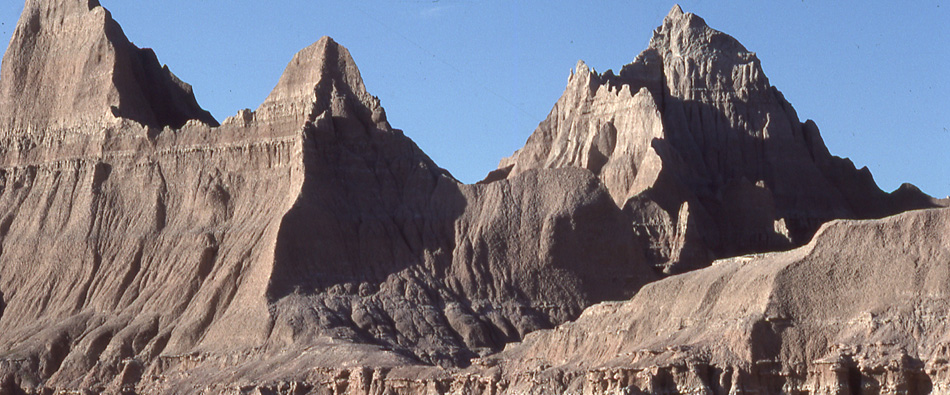|
The following images of Alaskan parklands have been extracted from an
assortment of Administrative Histories, Historic Resource Studies and other
reports covering some of the park units in Alaska.
Interspersed with these photos are U.S. postage stamps which were released by
the U.S. Postal Service (USPS) in 1934. The USPS produced 10 postage stamps
depicting scenes from various national parks. The images for these stamps were
taken from photographs by noted photographers such as Ansel Adams and the
National Park Service's Chief Photographer George Grant.
The photo albums, United States
National Parks (2010) and U.S.
National Parks Supplement (2012), created by the American Philatelic
Society, provide additional information about postage stamps which have
been produced for national parks. A
Philatelic Portfolio of America's National Parks (©Unicover
Corporation, 1972; electronic reproduction permission graciously granted by the
Unicover Corporation—all rights reserved), was published and designed for
the National Parks Centennial Commission to celebrate the 100th anniversary of
creating America's first national park (Yellowstone).
To celebrate the National Park Service Centennial, the U.S. Postal Service
released 16 Forever Stamps on June 2nd, 2016. "These stamps celebrate the 100th
anniversary of the National Parks and depict the beauty and diversity of these
national treasures," said Postmaster General Megan J. Brennan. "They serve as an
inspiration for Americans to visit, learn and to write cherished memories of
their trips to these incredible wonders." "This set of stamps will take people
on a journey to some of the most amazing places in the world," said National
Park Service Director Jonathan B. Jarvis. "We are thrilled that the 16 national
park stamps issued in '16 for the centennial depict the variety of parks that
collectively tell the story of our country." All 16 of these stamps are shown below (text provided by U.S. Postal Service).
Historical Photos and Art

(U.S. Postal Service)
|

Denali National Park
Looking up to the head of the east branch of the Teklanika River.
(from The Wolves of Mount McKinley Fauna Series No. 5)
|

Katmai National Park and Preserve
Kaguyak Crater. Aerial view from the southwest. Beyond the crater
rim is Big River and, on the center horizon, Four-peaked Mountain. The lake in the caldera is about 1-3/4 miles long. Cliff on the
east (right) rim towers 1,800 feet above the water.
(from A Biological Survey of Katmai National Monument)
|

(U.S. Postal Service)
|

(U.S. Postal Service)
|

(U.S. Postal Service)
|

(U.S. Postal Service)
|

(U.S. Postal Service)
|

(U.S. Postal Service)
|

(U.S. Postal Service)
|

(U.S. Postal Service)
|

(U.S. Postal Service)
|
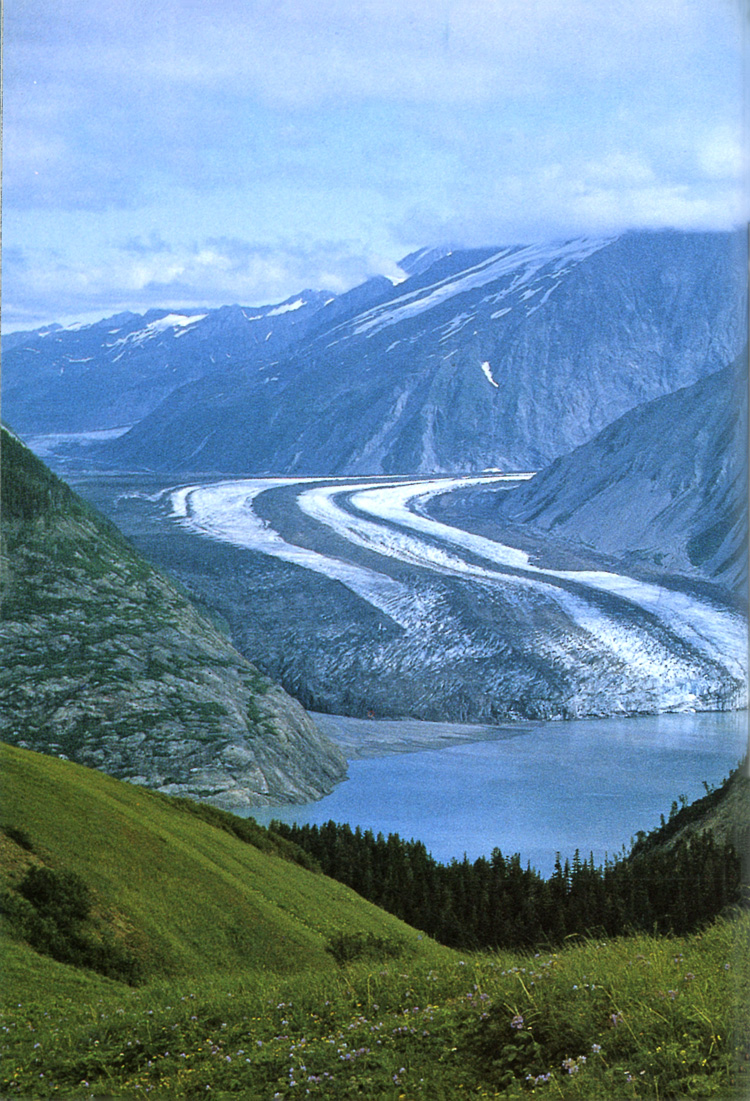
Lituya Bay and Glacier, Glacier Bay National Park and Preserve
(NPS photo, from Glacier Bay: A Guide to Glacier Bay National Park and Preserve, Alaska, Official National Park Handbook No. 123)
|
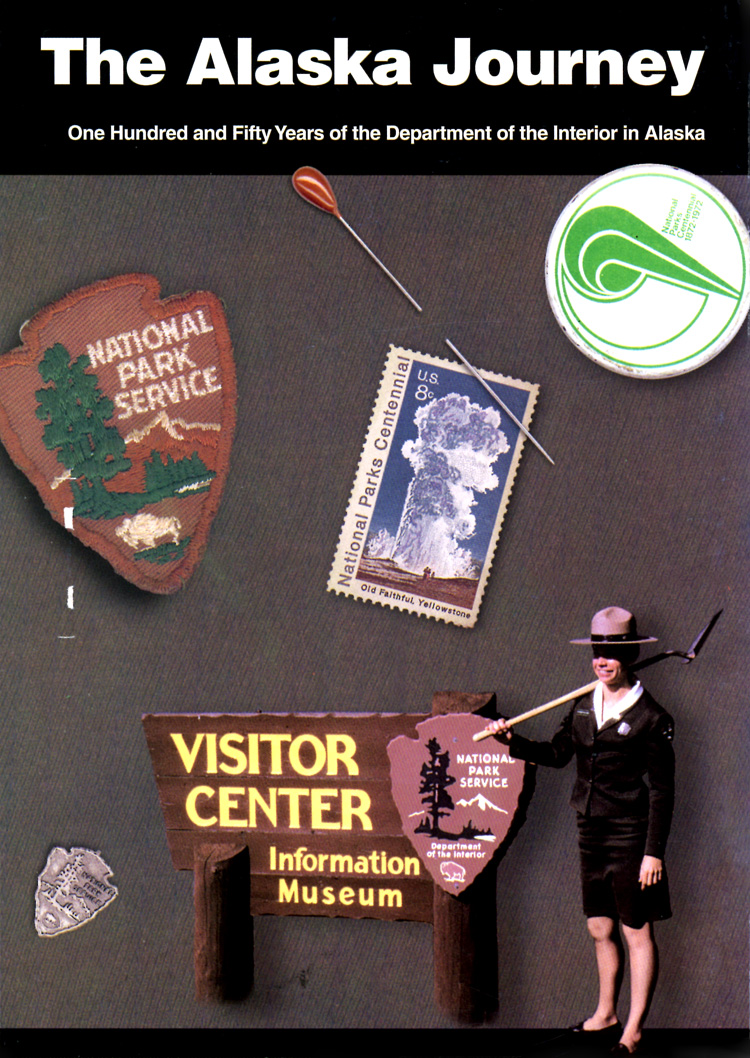
(NPS, from The Alaska Journey: One Hundred and Fifty Years of the Department of the Interior iin Alaska)
|
NPS Centennial Forever Stamps (U.S. Postal Service)
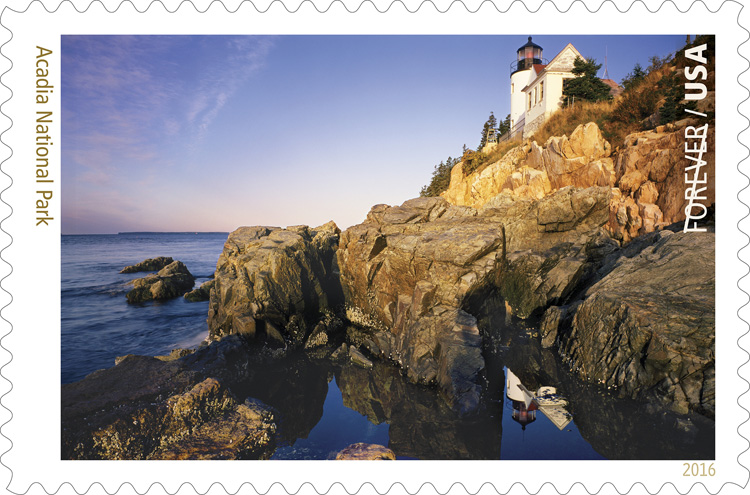
Acadia National Park, Bar Harbor, ME |
The stamp image depicting the Bass Harbor
Head Light was photographed by David Muench. People have been drawn to the
rugged coast of Maine throughout history. Awed by its beauty and diversity,
early 20th-century visionaries donated the land that became Acadia National
Park. The park is home to many plants and animals, and the tallest mountain on
the U.S. Atlantic coast. Today visitors come to Acadia to hike granite peaks,
bike historic carriage roads, or relax and enjoy the scenery. |
|
(©2016 U.S. Postal Service)
|
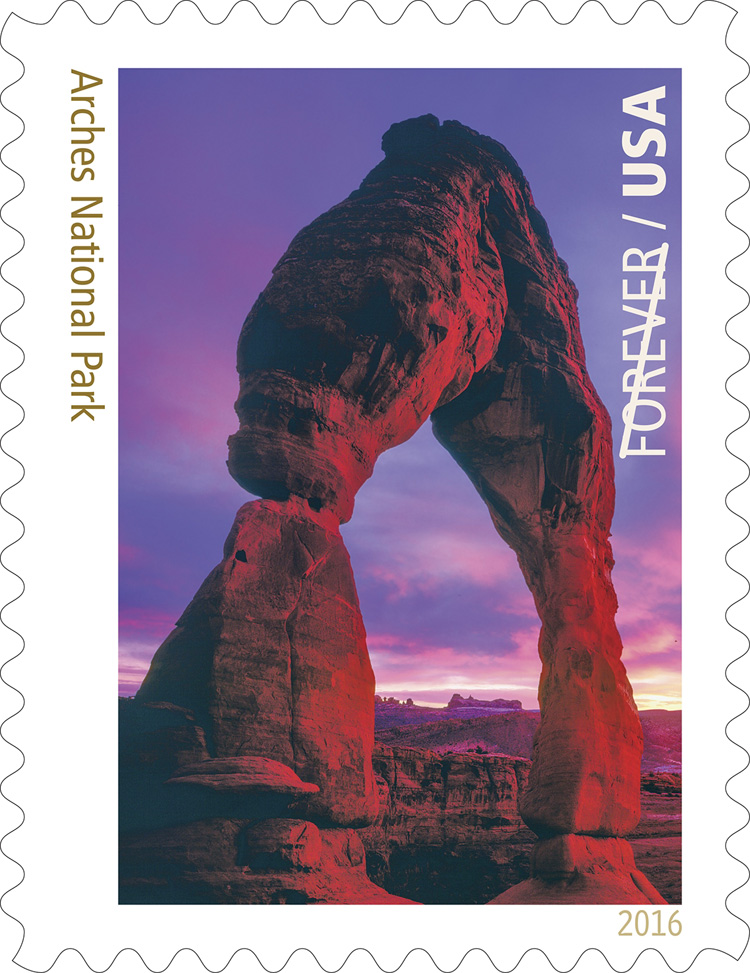
Arches National Park, Moab, UT |
The stamp image is a photograph by Tom Till of Moab, UT, and represents the
iconic Delicate Arch. Delicate Arch is just one of more than 2,000 stone arches
in a park that contains the greatest density of natural arches in the world. The
park is a landscape of contrasting colors, landforms and textures with thousands
of natural stone arches, hundreds of soaring pinnacles, massive fins and giant
balanced rocks. |
|
(©2016 U.S. Postal Service)
|
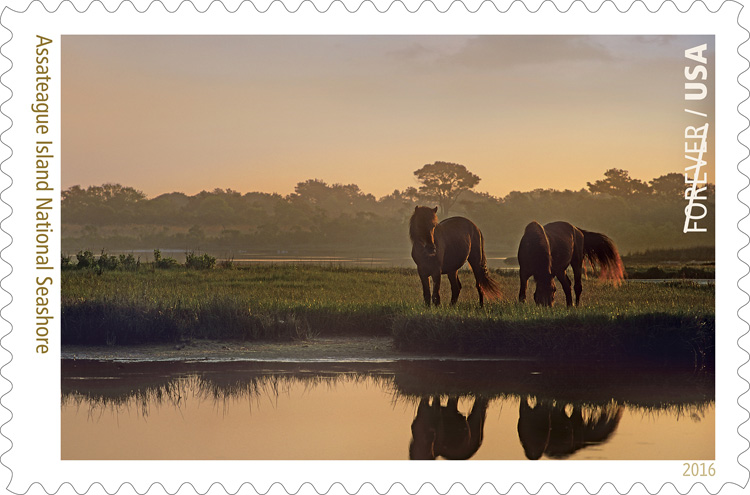
Assateague Island National Seashore, MD and VA |
This barrier island is a tale of constant movement and change. Explore sandy
beaches, salt marshes, maritime forests and coastal bays. Bands of wild horses
freely roam amongst plants and native animals that have adapted to a life of
sand, salt and wind. |
|
(©2016 U.S. Postal Service)
|
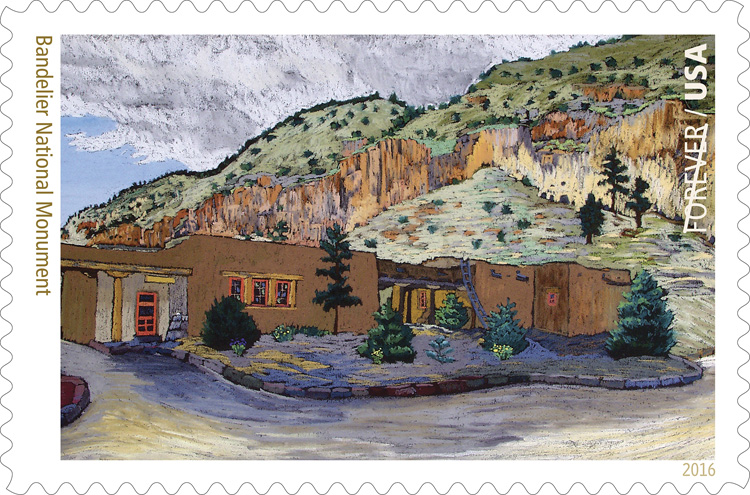
Bandelier National Monument, NM |
The stamp image is a 1935-1936 pastel-on-paper depiction by Helmuth Naumer, Sr.
(1907-1990) of the visitor center in Frijoles Canyon. Bandelier National
Monument protects over 33,000 acres of rugged, beautiful canyon and mesa country
as well as evidence of a human presence here going back more than 11,000 years.
Petroglyphs, dwellings carved into the soft rock cliffs, and standing masonry
walls pay tribute to the early days of a culture that still survives in the
surrounding communities. |
|
(©2016 U.S. Postal Service,
Administration Building, Frijoles Canyon Helmuth Naumer Sr. Bandelier
National Monument, BAND 1409)
|
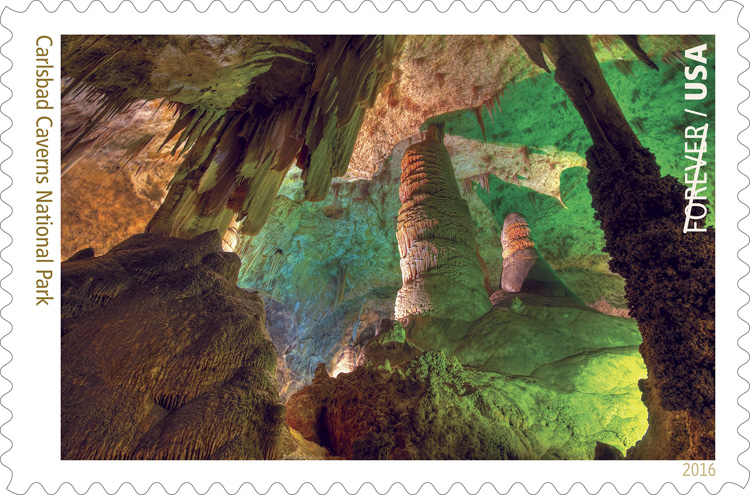
Carlsbad Caverns National Park, NM |
The stamp image is a photograph by Richard McGuire of the interior of the
caverns. High ancient sea ledges, deep rocky canyons, flowering cacti and desert
wildlife are all treasures above and below the Chihuahuan Desert ground.
Carlsbad Cavern is one of more than 300 limestone caves in a fossil reef laid
down by an inland sea 240 million to 280 million years ago. |
|
(©2016 U.S. Postal Service)
|
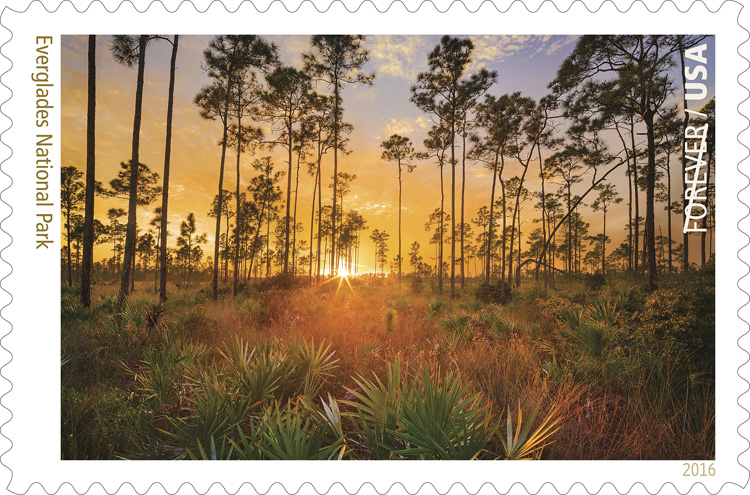
Everglades National Park, FL |
The stamp image is a photograph by Paul Marcellini of Miami, FL. Spanning the
south Florida peninsula from Miami to Naples and south to the Florida Keys,
Everglades National Park's 1.5 million acres of sawgrass prairies, tropical
hardwood hammocks, pine rocklands, mangrove forests and marine and estuarine
waters provide habitat for a wildlife spectacle like no other. Crocodiles,
alligators, manatees, flamingos, herons and turtles are just a small sampling of
wildlife that can be seen here. |
|
(©2016 U.S. Postal Service)
|
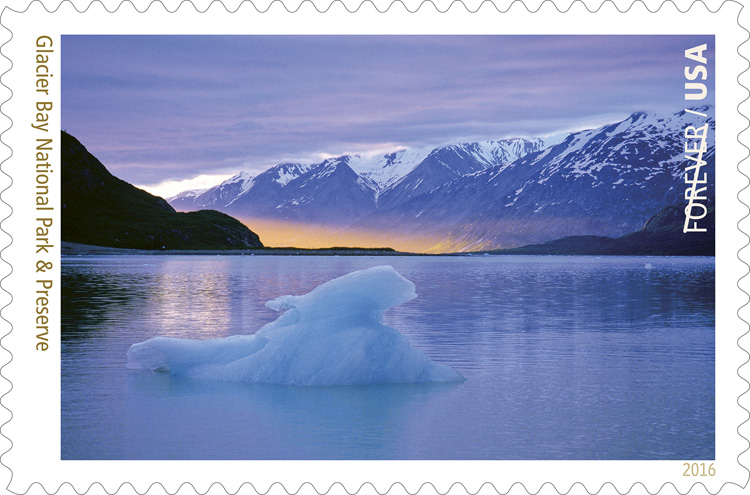
Glacier Bay National Park and Preserve, AK |
The stamp image is a photograph by Tom Bean of Flagstaff, AZ. Covering 3.3
million acres of rugged mountains, dynamic glaciers, temperate forests, wild
coastlines and deep sheltered fjords, Glacier Bay National Park and Preserve is
a highlight of Alaska's Inside Passage and part of a 25-million acre World
Heritage Site — one of the world's largest international protected areas. From
sea to summit, Glacier Bay National Park and Preserve offers limitless
opportunities for adventure and inspiration. |
|
(©2016 U.S. Postal Service)
|
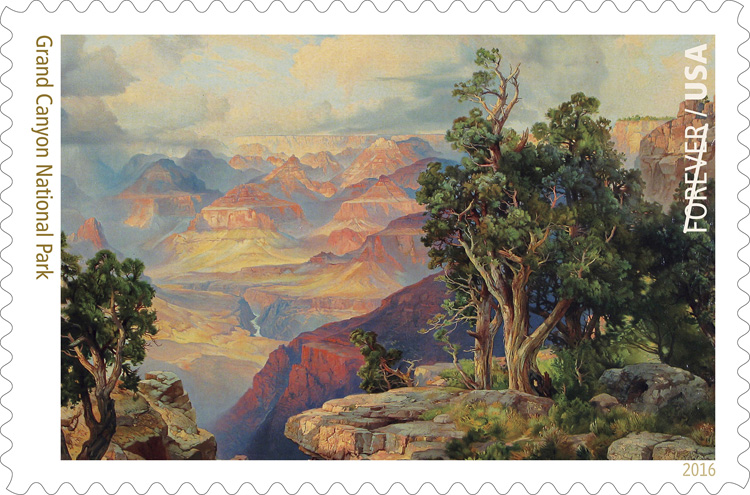
Grand Canyon National Park, AZ |
The stamp image is a detail of a chromolithograph-on-canvas, "The Grand Canyon
of Arizona, from Hermit Rim Road," by artist Thomas Moran (1837-1926). Unique
combinations of geologic color and erosional forms decorate a canyon that is 277
river miles long, up to 18 miles wide and one mile deep. Grand Canyon overwhelms
our senses through its immense size. |
|
(©2016 U.S. Postal Service, The Grand
Canyon of Arizona, from Hermit Rim Road [detail] Thomas Moran Grand Canyon
National Park, GRCA 134696)
|
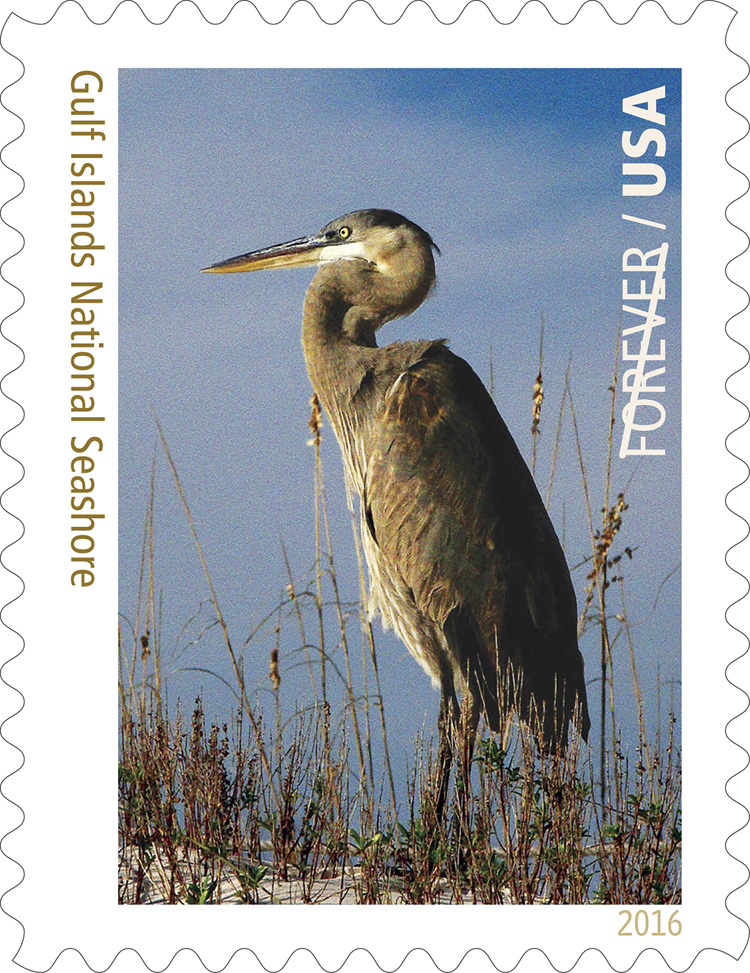
Gulf Islands National Seashore, FL and MS |
The stamp image is a photograph of a heron by John Funderburk of Hernando, FL.
Whether you visit the seashore for a day or a week there are many activities and
places to explore. Each of the seashore's many areas in Florida and Mississippi
offer unique experiences. |
|
(©2016 U.S. Postal Service)
|
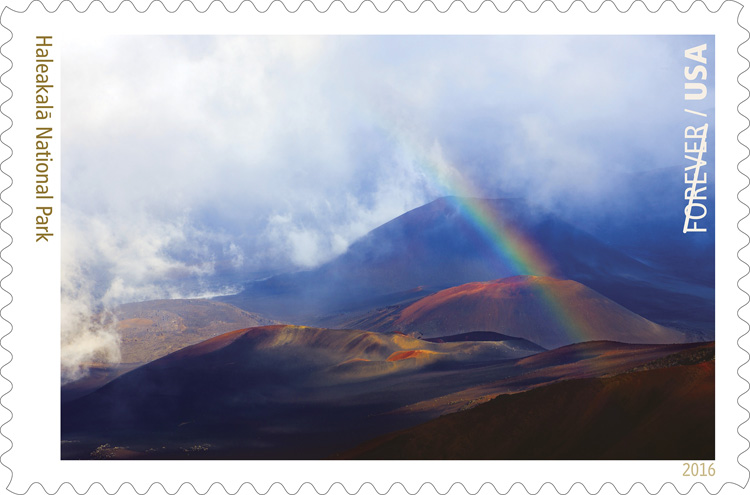
Haleakala National Park, HI |
Haleakala National Park vibrates with stories of ancient and modern Hawaiian
culture and protects the bond between the land and its people. The park also
cares for endangered species, some of which exist nowhere else. Come visit this
special place — renew your spirit amid stark volcanic landscapes and
sub-tropical rain forest with an unforgettable hike through the backcountry.
The photograph is the work of Kevin Ebi, who lives near Seattle, WA. Following
is his narrative of capturing the image:
"When you think of Hawaii, you probably imagine continuous summer, warm water
and hot beaches. But a couple hours after landing on Maui, I was in the freezing
cold, pelted by hail, surrounded by thunderclouds. For a few minutes at a time,
the sun would briefly break through it, using rainbows as spotlights to
illuminate Haleakala's volcanic cinder cones.
As a nature photographer, I was in heaven — or at least 10,000 feet closer to
it.
Whether it's because of the explosive growth of photography, or our need to take
a break from our always-on, connected lives, our national parks are busier than
ever. But for me, they can still be wondrous places of solitude. Such was the
case that afternoon I spent chasing Haleakala's rainbows.
My day started as a scouting trip. Haleakala is known for stunning sunrises.
Getting that sunrise would require me to arrive at my shooting location while it
was still dark. I decided to take a look at the crater during the day in order
to determine where I wanted to be the next morning.
But the closer I got to Haleakala's summit, the less I could see. The fog got
thicker and thicker. Then there was heavy rain. Then the rain turned to hail. I
sprinted from the car into the visitor center, hoping to catch a bit of the view
through the window. All I could make out was the railing of the viewing
platform.
It quickly became clear that the storm wouldn't stop. The few visitors in the
center sprinted to their cars. I decided to stay put.
Then something amazing happened. The hail turned into a light drizzle. Sunlight
poked through a tiny hole in the ominous cloud. And a rainbow dipped into the
crater.
I managed to get a few shots before the sun slid back behind the storm clouds
and the pelting hail resumed. It was a beautiful scene. Much of Haleakala's
beauty comes from its rainbow-colored rocks. The rainbow in the sky complemented
that nicely.
But I hoped for better placement of the rainbow. In those first images it was
off to the side of the crater. I knew that as the sun moved across the sky,
weather permitting, rainbows later in the day would land closer to a core group
of cinder cones that I found especially attractive. And so I waited.
During the hour and a half I spent on the rim, the storm gave me just six
opportunities to photograph rainbows. My favorite image — and the one that is
used on the stamp — was taken during the next-to-last 'window.' It was also the
briefest opportunity. I was able to shoot only a single frame before the rainbow
vanished.
Back in the car, with the heat and the de-fogger set on high, I was thankful for
the experience even though I was soaked. In all of my work as a photographer, I
treasure most the images that show nature at its dynamic finest. Braving an
intense hailstorm is just part of the experience — a key part of the experience.
National parks take us into a different world, a world of jaw-dropping scenery
and experiences that are dramatically different from our daily lives. This image
of Haleakala is both to me. And it's why I'm so honored that it will help
commemorate the 100th anniversary of the National Park Service." |
|
(©2016 U.S. Postal Service)
|
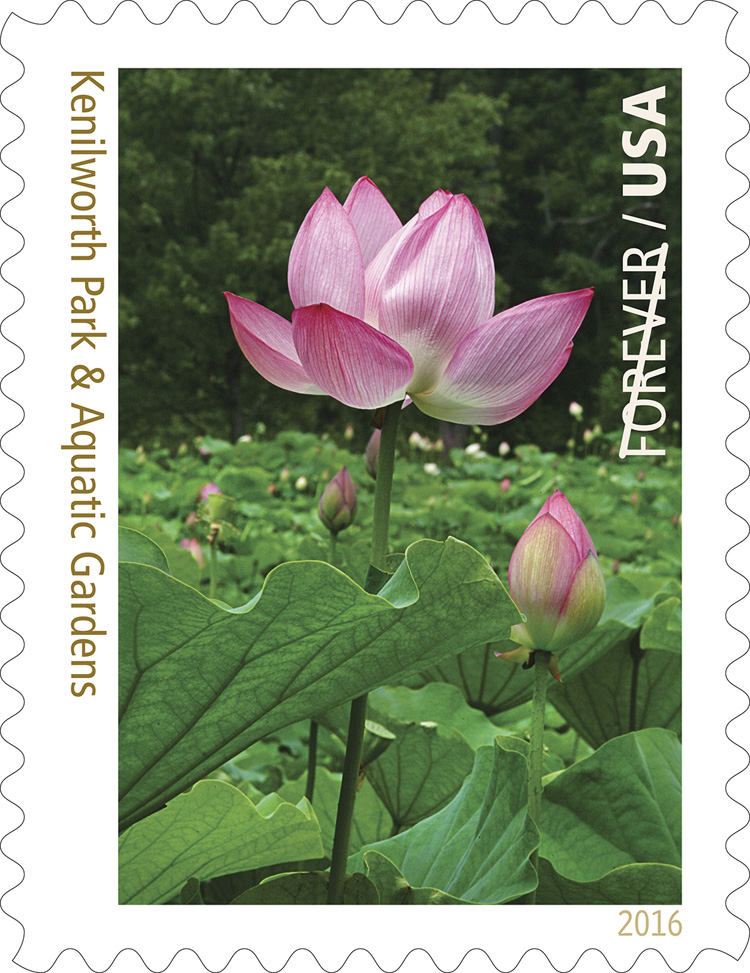
Kenilworth Park & Aquatic Gardens, DC |
The stamp image was photographed by Cindy Dyerof Alexandria, VA, who also
provided the images from Kenilworth for the Water Lilies Forever Stamps issued
last year.
The water lilies are a sample of the hidden treasures tucked away in this time
capsule surrounded by urban neighborhoods in our nation's capital. The original
water lilies were planted by a Civil War veteran who bought the 30-acre parcel
in the 1880s. The park's wetlands also provide habitat for many animals
including fox, mink and otter. |
|
(©2016 U.S. Postal Service)
|
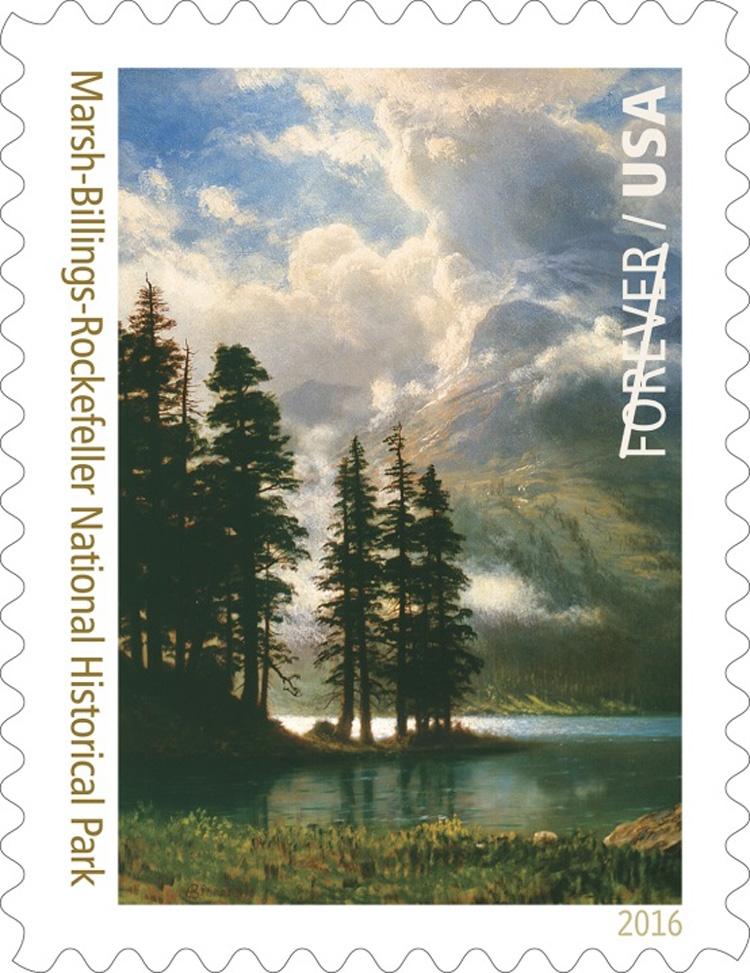
The stamp image is an iconic Hudson River School
of Art landscape painting linked to the Conservation Movement that supported
interest in creating the National Park system. |
"This stamp exemplifies how our national park treasures extend beyond stunning
vistas, wildlife, flora and fauna," said Stephanie Toothman, Associate Director,
Cultural Resources, Partnerships, and Science, National Park Service. "Albert
Bierstadt's painting represents the convergence of artistic, literary and
political attention toward America's scenic beauty in the 19th century, which
helped establish conservation as a national value and laid the foundation for
the first national parks a century ago."
The stamp image is a detail of Bierstadt's (1830-1902) 29-by-43-inch
oil-on-canvas painting "Scenery in the Grand Tetons." The permanent home of the
painting is Laurance Rockefeller's study in the Marsh-Billings-Rockefeller
Mansion. The stamp image, available for media use only, requires the following
credit: Scenery in the Grand Tetons [detail] Albert Bierstadt,
Marsh-Billings-Rockefeller National Historical Park, MABI 2843
The Conservation Movement and the Marsh-Billings-Rockefeller National Historical Park (NHP)
The fine art collection at Marsh-Billings-Rockefeller National Historical Park
is one of the gems of the National Park Service and includes 500 nature and
landscape paintings, many by artists associated with the Hudson River School.
The collection also includes folk art, modern art, portraits and sculpture.
According to the National Park Service, Rockefeller acquired the painting in the
1960s and added it to the collection of the Marsh-Billings-Rockefeller Mansion
as "a reminder of his family's long loyalty to Grand Teton National Park, and
the preservation of the mountains, lake and valley in that spectacularly
beautiful and dramatic part of the West."
The Hudson River School Art Movement
During the 19th century, the artists of a young America searched for a new world
view and found it in the very landscapes around them. Inspired by the stunning
natural beauty from across the nation, the loose-knit Hudson River School of
painters flourished from the mid-1830s to the mid-1870s and gave America its
first major school of art.
According to the National Park Service, "Their landscapes sought to recreate the
majesty of the natural world and to inspire admiration for its beauty."
Americans who bought their paintings and admired them on the walls of their city
homes came to believe that those scenes should be preserved for future
generations, not just painted or photographed.
At the same time, the works of authors such as Nathaniel Hawthorne, Henry David
Thoreau and Ralph Waldo Emerson also celebrated the beauty and importance of
nature.
Marsh-Billings-Rockefeller National Historic Park
The name of the park honors three individuals and their families who played
important roles in American conservation history: George Perkins Marsh
(1801-1882), Frederick Billings (1823-1890) and Laurance S. Rockefeller
(1910-2004).
The lives and contributions of these three generations of stewardship reflect
the wide range of attitudes and ideas in the evolution of the conservation
movement in the United States. The site was the boyhood home of G. P. Marsh, one
of America's first conservationists, whose 1864 book, Man and Nature, decried
the effects of deforestation in Vermont and around the world and provided the
intellectual underpinnings of the early conservation movement.
Later, it was the home of Billings, who returned to his native Vermont from
California, transformed the property into a progressive farm and country estate,
and reforested much of the land around the Mansion. Its most recent owners,
Billings' granddaughter Mary Rockefeller and her husband Laurance Rockefeller,
gave the property and its collections to the American people, the latest in a
long history of support for National Parks by the Rockefeller family.
Rockefeller received the Congressional Gold Medal in 1991 for his contributions
to conservation and historic preservation. |
|
(©2016 U.S. Postal Service, Scenery in
the Grand Tetons [detail] Albert Bierstadt, Marsh - Billings - Rockefeller
National Historical Park, MABI 2843)
|
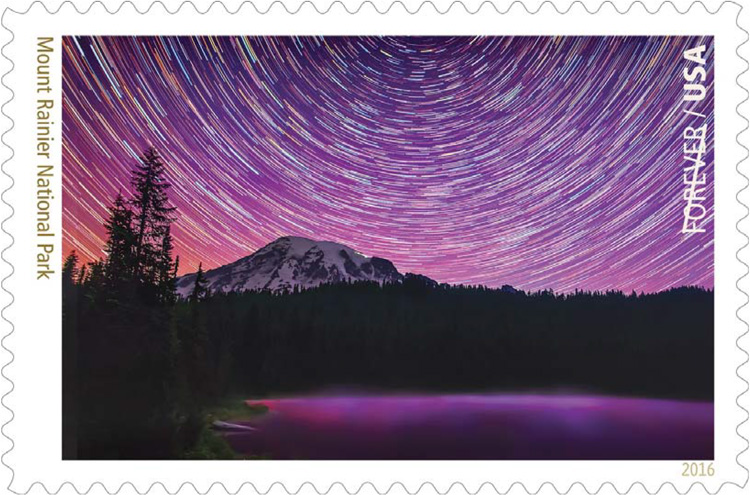
Mount Rainier National Park, WA |
Ascending to 14,410 feet above sea level,
Mount Rainier stands as an icon in the Washington landscape. An active volcano,
Mount Rainier is the most glaciated peak in the contiguous United States,
spawning six major rivers. Subalpine wildflower meadows ring the icy volcano
while ancient forest cloaks Mount Rainier's lower slopes. Wildlife abounds in
the park's ecosystems. A lifetime of discovery awaits.
Creating the Star Trail Photo
The stamp image is the creation of Matt Dieterich of Pittsburgh, PA. "This night
was one I will never forget," said Dieterich, who worked at Mount Rainier as an
intern with the National Park Service Geoscientist-in-the-Parks to educate the
public on dramatic views of the stars and the effect of light pollution near
highly populated areas. "After working with visitors at the Mount Rainier
astronomy program on June 22, 2015, I noticed there was an aurora, so I drove
down to Reflection Lake to capture it."
"The location was perfect as it contained a view of Mount Rainier and water for
reflections," he continued. "To create this star trails image I took 200 photos
in a two-hour window between 2 a.m. and 4 a.m. with my Nikon D750 and 24mm lens
set at F/1.4 and ISO 5000. Since the Earth is rotating, each 8-sec. exposure
shows stars at slightly different locations. When the photos are combined into
one image the stars create a circular pattern around the North Star, which is
just out of view at the top of the image. The pink aurora spread throughout the
background sky. Mountaineers can be seen with their white headlamps climbing
Mount Rainier on the right side of the volcano."
"To capture star trails photos just like this," he added, "all you need is a
digital single lens reflex camera, a wide angle lens, tripod and shutter release
cable. So what are you waiting for? Grab your gear and get out under the
stars!" |
|
(©2016 U.S. Postal Service)
|
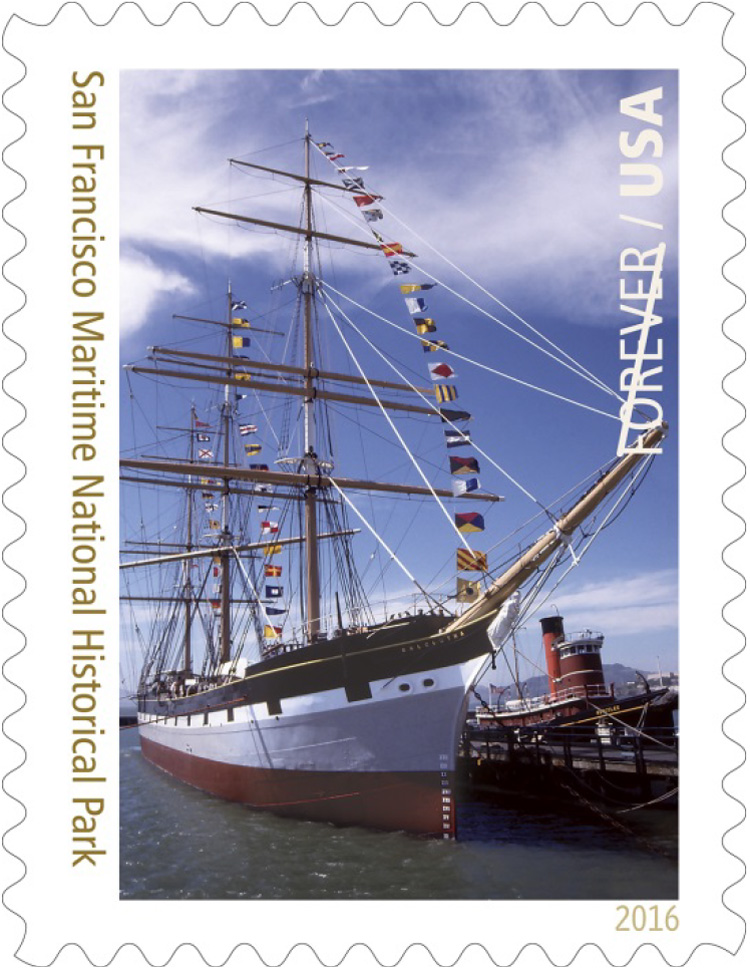
San Francisco Maritime National Historic Park, CA |
The Balclutha, an iconic three-masted sailing ship, is a portion of a
photograph by Tim Campbell of San Francisco, CA. Just visible to the right of
the deep waterman/salmon packet sailing vessel is the 1907 steam tugboat
Hercules.
Located near the Fisherman's Wharf neighborhood, San Francisco Maritime National
Historical Park offers the sights, sounds, smells and stories of Pacific Coast
maritime history through five National Historic Landmark vessels berthed
here. |
|
(©2016 U.S. Postal Service,
Balclutha, San Francisco Maritime National Historical Park)
|
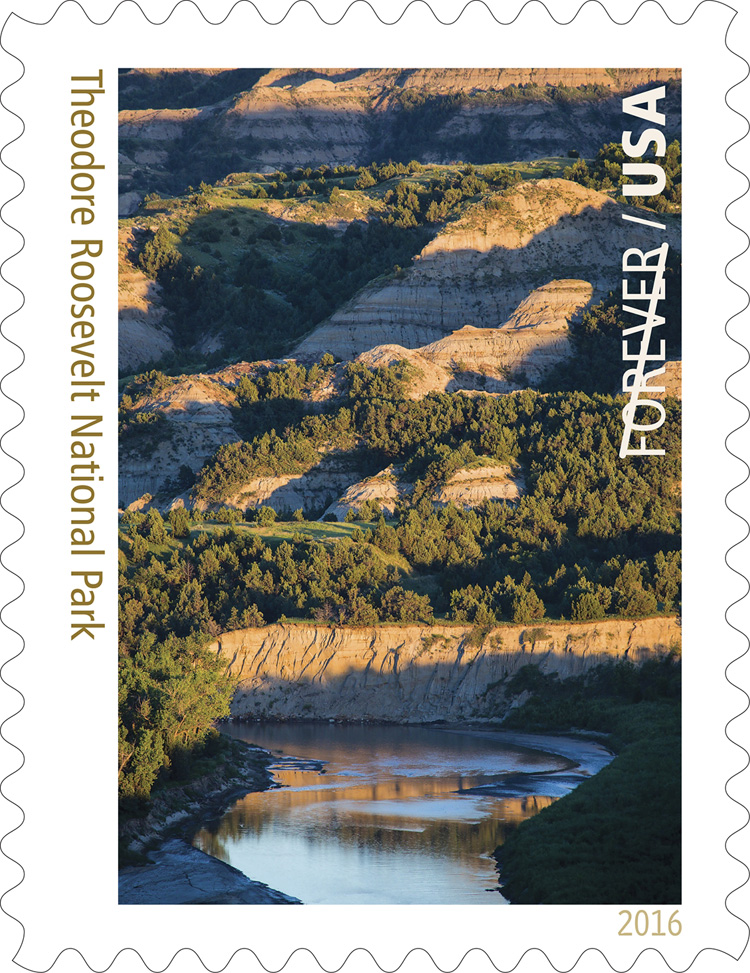
Theodore Roosevelt National Park, ND |
A photograph of the Little Missouri River
winding through the Badlands of North Dakota's Theodore Roosevelt National Park
was taken in July 2013 by Q.T. Luong of San Jose, CA, who captured the image in
the North Unit of Theodore Roosevelt National Park in the course of his 20-year
project to photograph 59 national parks.
According to the National Park Service, when Theodore Roosevelt came to Dakota
Territory to hunt bison in 1883, he was a "skinny, young, spectacled New
Yorker." He could not have imagined how his adventure in this remote and
unfamiliar place would forever alter the course of the nation. The rugged
landscape and strenuous life he experienced here would help shape a conservation
policy that we still benefit from today.
Theodore Roosevelt National Park contains several sites of historical
significance, each relating to the era of cattle ranching in the late 1800s.
Most significant is Theodore Roosevelt's Elkhorn Ranch Site, the main ranch site
where he spent the bulk of his time and where many of his conservation ideas
grew. Roosevelt's first ranch home, the Maltease Cross Cabin, is open for
viewing at the South Unit Visitor Center.
The Long X Trail was used as a corridor to move cattle into the Northern Great
Plains in the 1800s, and it passes through the North Unit of the park. Peaceful
Valley Ranchwas built in the 1880s and served as a dude ranch from 1918 to the
1930s. The ranch and its owners assisted in the establishment of Theodore
Roosevelt National Park. Visitors can still ride horses at Peaceful Valley by
taking part in a trail ride with the park's concessionaire.
The Backstory of Luong's Photograph
Luong was interested in the park's rugged character and vegetation that set it
apart from South Dakota's Badlands National Park.
"The light of the late afternoon gleaming on the river appeared as a bright
ribbon in the landscape," recounted Luong, who used a telephoto lens to
emphasize the section of the river with the reflection.
Luong noted that the park includes three units: the South Unit and the far
lesser visited North Unit and Elkhorn Ranch Site.
"The Little Missouri River provides a link between them, reminding me of the
fond memories I cherish from the time I spent there."
Born in Paris, France, Luong trained as a computer scientist. When he came to
the United States for what was intended to be a short academic stay, he chose
the University of California at Berkeley because of its proximity to Yosemite
and his passion for rock-climbing — where he scaled El Capitan several times.
"Upon visiting Yosemite for the first time in 1993, it was love at first sight
and it marked the start of my 20-year affair with the national parks. I decided
to photograph all of them with a 5 by 7 large format camera, a single-handed,
self-financed, monumental project which, as far as I know, had not been
completed by anyone before."
Luong settled in the San Francisco Bay area and started crisscrossing the nation
to capture its diverse beauty. By 2002, he had visited 58 national parks. He
subsequently left his scientific career to pursue his calling of working as a
full-time photographer. In 2009, Ken Burns and Dayton Duncan featured him in the
film "The National Parks: America's Best Idea." |
|
(©2016 U.S. Postal Service)
|
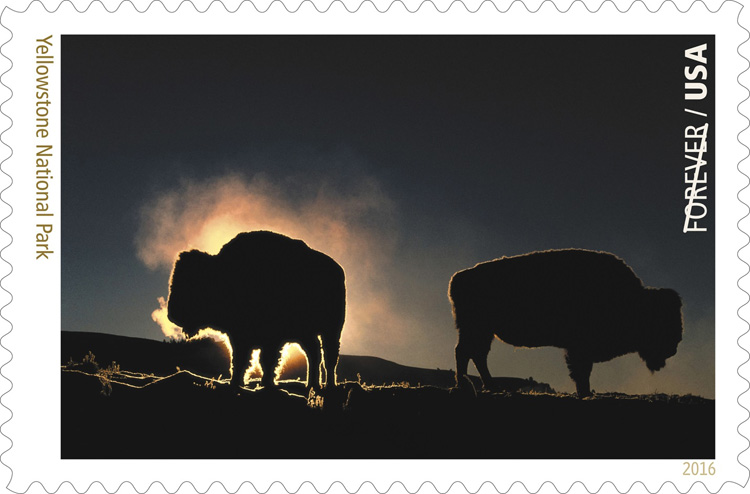
Yellowstone National Park, ID, MT and WY |
A stunning photograph of two bison
silhouetted in Yellowstone National Park's winter morning sun was captured by
Art Wolfe of Seattle, WA, who described it as, "perfectly backlit bison standing
on a small rise in Yellowstone's Lamar Valley."
"Rising at dawn and braving the -30°F temperature I was able to catch the first
rays of the morning sun," he explained. "The bitter cold of a long winter's
night had left the animals encased in a mantle of thick frost. I had scouted the
area the day before and had seen the herd of bison. They had bedded down there
all night and now were standing and trying to shake off the cold as the sun came
over the horizon. These are the serendipitous moments I wait for as a
photographer. I shot this in the days of film, so I didn't know until I got back
to Seattle and had the film processed if I had been successful or not."
Wolfe got the February 2000 shot using a Canon EOS-3, EF70-200mm lens set at
f/16 for 1/250 sec. using Fujichrome Velvia film.
Marvel. Explore. Discover. Visit Yellowstone and experience the world's first
national park. Marvel at a volcano's hidden power rising up in colorful hot
springs, mud pots and geysers. Explore mountains, forests and lakes to watch
wildlife and witness the drama of the natural world unfold. Discover the history
that led to the conservation of our national treasures "for the benefit and
enjoyment of the people." |
|
(©2016 U.S. Postal Service)
|
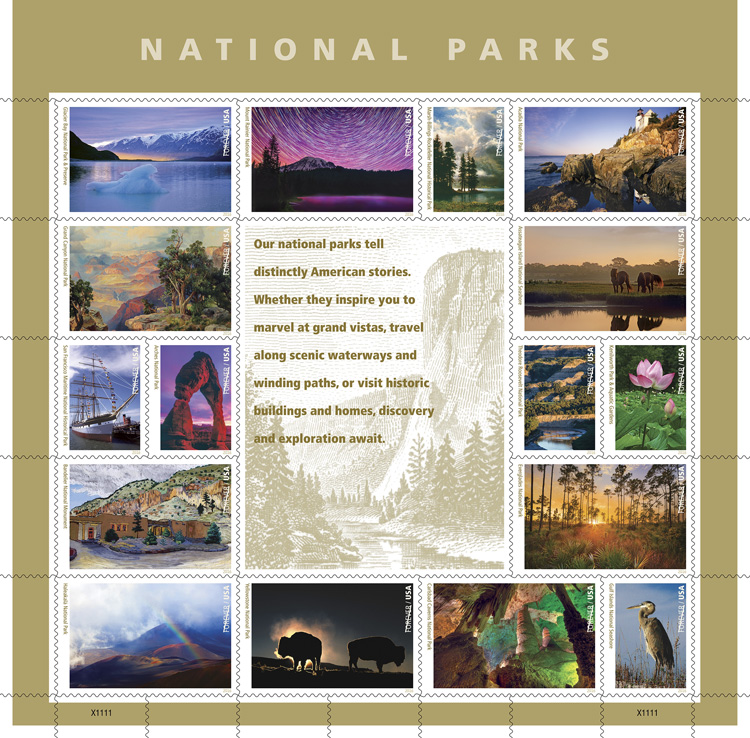
National Parks Forever Stamps
100th Anniversary of the National Park Service |
The June 2 first-day-of-issue ceremony took
place at New York City's Jacob Javits Center as part of World Stamp Show-NY
2016, the world's largest stamp show that takes place in the United States once
a decade. Dedication ceremonies also took place at or near each of the national
parks associated with the stamps.
Designing the National Parks Stamp Pane
The National Park System consists of more than 400 park sites. The stamp pane,
designed by Ethel Kessler of Bethesda, MD, includes 16 stamp images featuring
existing art or photography representing the regional diversity of the National
Park System. All stamps show national parks or plants, animals, artwork, objects
and structures found in or associated with a national park. Small type on the
margin of each stamp indicates the park's location.
Kessler arranged the stamps to approximate their locations around America:
Alaska's Glacier Bay National Park and Preserve on the upper left; Maine's
Acadia National Park on the upper right; Hawaii's Haleakala National Park on the
bottom left; and Florida's and Mississippi's Gulf Islands National Seashore on
the bottom right.

Top Row
The top row includes four stamps. The first features a photograph by Tom Bean of
Flagstaff, AZ, of Glacier Bay National Park and Preserve in Alaska. The second
features a photograph by Matt Dieterich of Pittsburgh, PA, of Mount Rainier
National Park in Washington State
(see his time lapse video).
The third shows a detail from the oil-on-canvas painting "Scenery in the Grand
Tetons" by Albert Bierstadt (1830-1902), currently held at
Marsh-Billings-Rockefeller National Historical Park in Vermont. The fourth is a
photograph by David Muench of Goleta, CA, of Bass Harbor Head Light at Acadia
National Park in Maine.
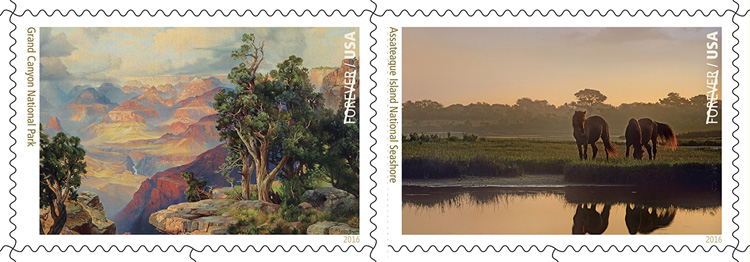
Second Row
The second row from the top includes two stamps, one on either side of the
central selvage image. The stamp on the left features a detail of a
chromolithograph-on-canvas, "The Grand Canyon of Arizona, from Hermit Rim Road"
by artist Thomas Moran (1837-1926) from the collection of Grand Canyon National
Park in Arizona. The stamp on the right features a photograph by Tim Fitzharris
of Fayetteville, AR, of wild horses at Assateague Island National Seashore,
located in Maryland and Virginia.
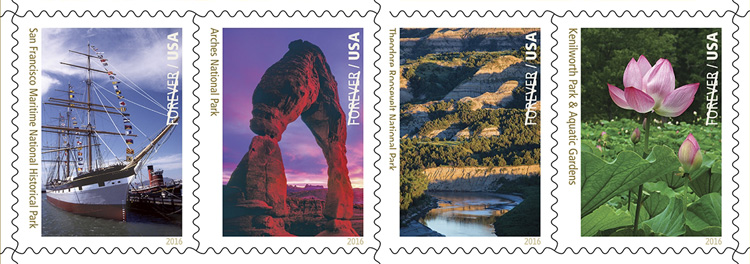
Third Row
The third row from the top includes four stamps, two on either side of the
central selvage image. The first stamp on the left features a detail of a
photograph by Tim Campbell of Balclutha, a ship at San Francisco Maritime
National Historical Park. The second stamp on the left shows a photograph by Tom
Till of Moab, UT, taken at Arches National Park in Utah. The first stamp on the
right features a photograph by QT Luong of San Jose, CA, of Theodore Roosevelt
National Park in North Dakota. In 2009, Ken Burns and Dayton Duncan featured
Roosevelt in the film "The National Parks: America's Best Idea." The second
stamp on the right shows a photograph by Cindy Dyer of Alexandria, VA, taken at
Kenilworth Park & Aquatic Gardens in Washington, DC.
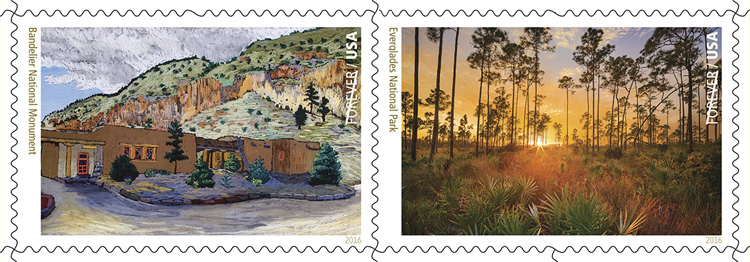
Fourth Row
The fourth row from the top includes two stamps, one on either side of the
central selvage image. The stamp on the left features a 1935-1936
pastel-on-paper depiction by Helmuth Naumer, Sr. (1907-1990) of the
Revival-style visitor center at Frijoles Canyon at Bandelier National Monument
in New Mexico. The stamp on the right features a photograph by Paul Marcellini of
Miami, FL, of Everglades National Park in Florida.

Fifth Row
The fifth and bottom row of the pane includes four stamps. The first features a
photograph by Kevin Ebi who lives near Seattle, WA, of Haleakala National Park
in Hawaii. The second shows a photograph by Art Wolfe of Seattle, WA, of bison
at Yellowstone National Park, located in Idaho, Montana and Wyoming. The third
stamp shows a photograph by Richard McGuire of Carlsbad Caverns National Park in
New Mexico. The fourth stamp features a photograph by John Funderburk of
Hernando, FL, of a heron at Gulf Islands National Seashore, located in Florida
and Mississippi.
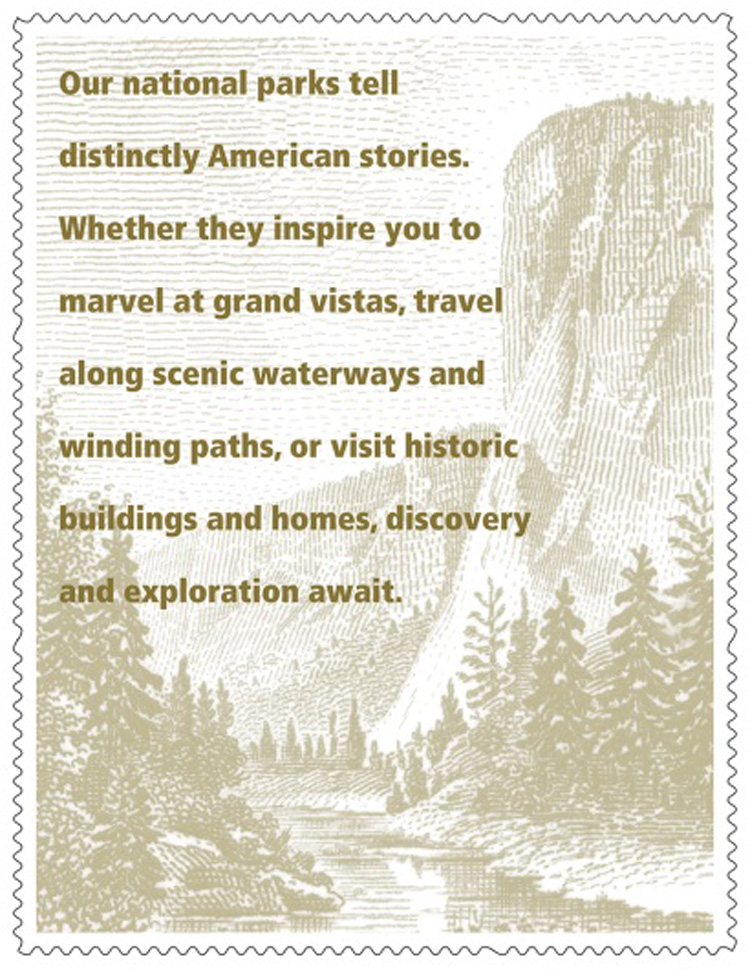
Center Image
The image in the center is a detail of artwork from the 1-cent Yosemite stamp
issued in 1934, rendered here in light brown. Text superimposed over the center
image reads: "Our national parks tell distinctly American stories. Whether they
inspire you to marvel at grand vistas, travel along scenic waterways and winding
paths, or visit historic buildings and homes, discovery and exploration await."
A banner across the top of the pane reads "NATIONAL PARKS."
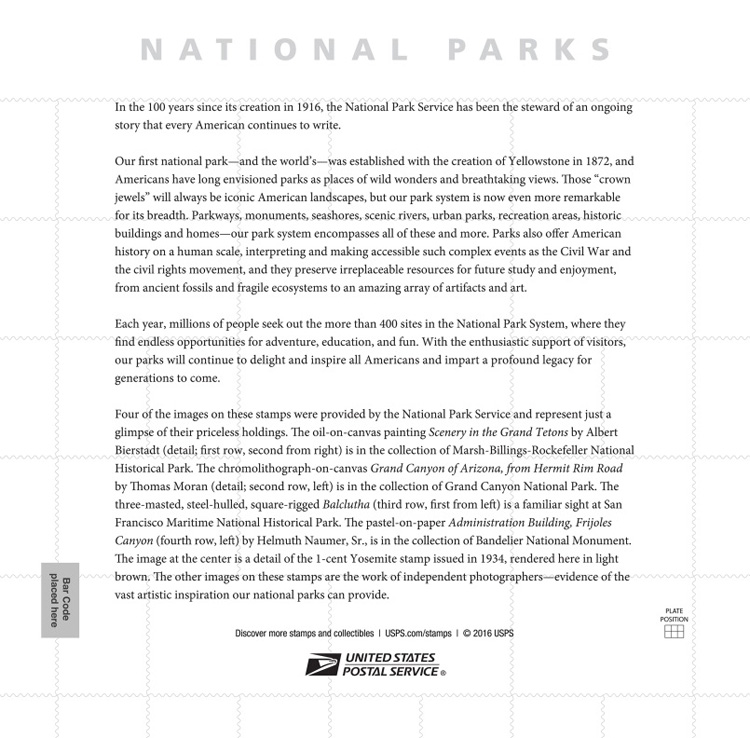
Text on the back of the stamp pane (verso text)
In the 100 years since its creation in 1916, the National Park Service has been
the steward of an ongoing story that every American continues to write.
Our first national park — as well as the world's — was established with the
creation of Yellowstone in 1872, and Americans have long envisioned parks as
places of wild wonders and breathtaking views. Those "crown jewels" will always
be iconic American landscapes, but our park system is now even more remarkable
for its breadth. Parkways, monuments, seashores, scenic rivers, urban parks,
recreation areas, historic buildings and homes — our park system encompasses all
of these and more. Parks also offer American history on a human scale,
interpreting and making accessible such complex events as the Civil War and the
civil rights movement, and they preserve irreplaceable resources for future
study and enjoyment, from ancient fossils and fragile ecosystems to an amazing
array of artifacts and art.
Each year, millions of people seek out the more than 400 sites in the national
park system, where they find endless opportunities for adventure, education, and
fun. With the enthusiastic support of visitors, our parks will continue to
delight and inspire all Americans and impart a profound legacy for generations
to come.
Four of the images on these stamps were provided by the National Park Service
and represent just a glimpse of their priceless holdings. The oil-on-canvas
painting Scenery in the Grand Tetons by Albert Bierstadt (detail; first
row, second from right) is in the collection of Marsh-Billings-Rockefeller
National Historical Park. The chromolithograph-on-canvas Grand Canyon of
Arizona, from Hermit Rim Road by Thomas Moran (detail; second row, left) is
in the collection of Grand Canyon National Park. The three-masted, steel-hulled,
square-rigged Balclutha (third row, first from left) is a familiar sight
at San Francisco Maritime National Historical Park. The pastel-on-paper
Administration Building, Frijoles Canyon (fourth row, left) by Helmuth
Naumer Sr., is in the collection of Bandelier National Monument. The image at
the center is a detail of the 1-cent Yosemite stamp issued in 1934, rendered
here in light brown. The other images on these stamps are the work of
independent photographers — evidence of the vast artistic inspiration our
national parks can provide. (End of verso text.) |
|
(©2016 U.S. Postal Service, Yosemite National Park (illustration); U.S. 1¢ postage [detail] 1934)
|
|

